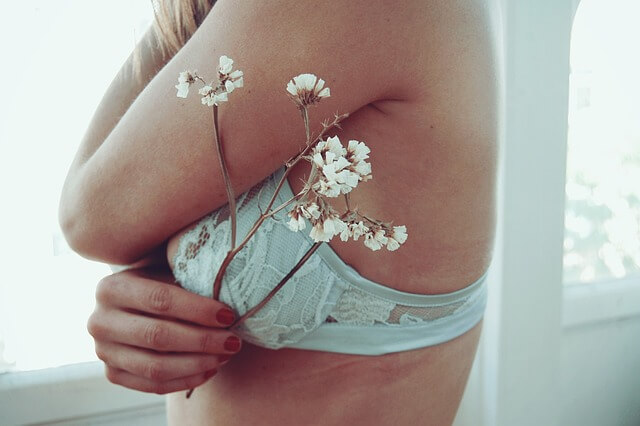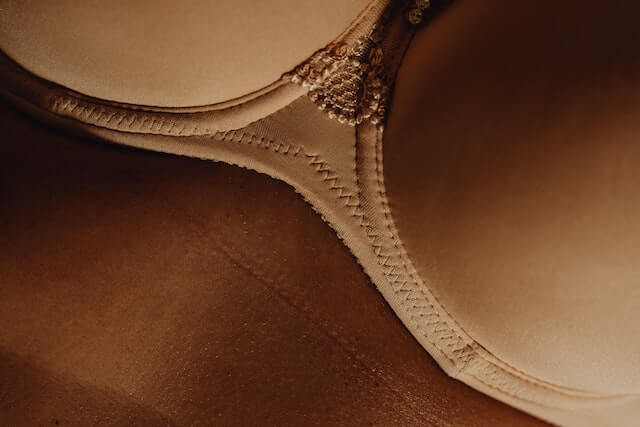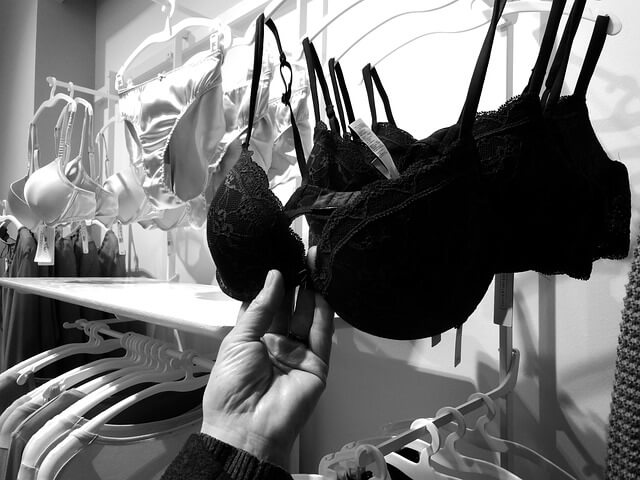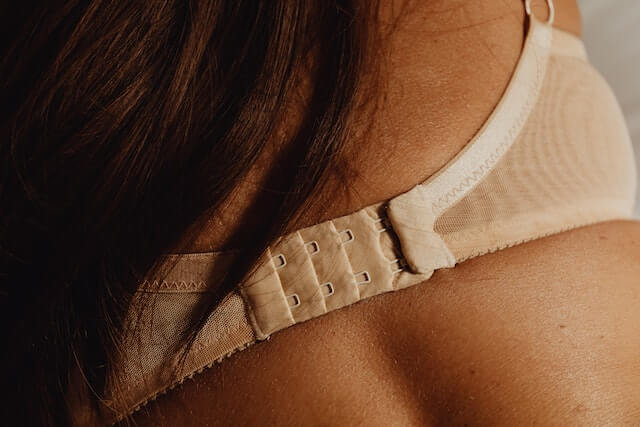Starting a bra business can be an exciting venture, but it’s important to have a solid understanding of bra anatomy before diving in.
As a bra seller or someone interested in starting a bra brand, having a comprehensive knowledge of the different parts of a bra is crucial. It can help you better understand the construction of your bras, allowing you to communicate effectively with customers regarding fit and sizing.
By the end of this article, you’ll have a thorough understanding of bra anatomy, enabling you to make informed decisions when purchasing, designing, or selling bras.
So, let’s dive right in!
1. Underband

The bra band plays a crucial role in supporting the breasts and achieving a perfect fit. It wraps around the rib cage and is where the cups and straps are attached.
The underband is practically the frame of the bra, and it includes the side panels or wings as well as the back piece and closure. We’ll see more about these bra parts further down.
A well-designed bra should distribute the weight of the breasts throughout the band. That’s why it’s essential to ensure the band is properly fitted to prevent discomfort and inadequate support.
2. Top of the Cup (Upper Bra Cup)

When you look at a bra cup and imagine it being cut it in half horizontally, the top half is called the upper cup. This part of the bra cup sits at the top of the breast and shapes the upper half of the cleavage.
The top of the cup can have some elastic to minimize any unwanted movement, but it’s usually reserved purely for decorative elements such as lace or silk edges.
3. Bottom of the Cup (Lower Bra Cup)

The bra’s lower cup usually provides support and shapes the bra cup. In push-up bras, the lower cup usually contains foam or padding to enhance the appearance of the bust. The bottom of the cup can also feature seams or darts to provide shaping and contouring to the breast. Proper fit of the lower cup is important to prevent any uncomfortable sagging or spilling over the cup.
4. Cup Side

The section of a bra that connects the side of the cup to the rest of the wings is known as the cup side. This part of the bra is important as it holds the breasts forward and prevents any side fat and breast tissue from spilling out.
To provide extra support and stability, the cup side may feature additional reinforcements such as boning or additional layers of fabric.
5. Cup Seams

Cup seams are important in creating different cup shapes on bras. They can run throughout the entire cup or extent just to the nipple from each side.
There are three main types of cup seams: 2-seam, 3-seam, and seamless. The choice of seam style can impact the level of support, shaping, and comfort the bra provides.
For instance, 3-seam bras can offer more structure and support, while seamless bras are often more comfortable for everyday wear.
Lastly, cup seams are often adorned with decorative stitching or trim for added style.
6. Center Gore (Bridge)

The center gore, also known as the bridge, is the triangular piece of fabric in the bra’s front part, between both bra cups.
Its position is a crucial indicator of proper bra fit – the gore should lie flat against the chest without a gap.
A properly fitting center gore can provide additional support and ensure optimal comfort. If the center gore is not lying flat against the chest, it’s a sign that the cup size is incorrect or that the bra style is not a perfect fit for the wearer’s body.
7. Underwire

Almost every good support bra has an underwire for high stability and shape, even with movement. The underwire is a thin, semi-circular strip of rigid material, usually metal, encased in a bra cup’s fabric.
The underwire sits directly beneath the breast tissue, following the natural curve of the ribcage.
It’s important to note that not all bras have an underwire, as some women may find them uncomfortable or ill-fitting.
8. Raised Bottom Edge

The raised bottom edge is not so much a part of a bra but rather a design feature that helps prevent discomfort while sitting down.
Instead of having a straight edge at the bottom of the center gore, which can dig into the chest, the bottom edge is raised and curved to provide a more comfortable fit.
This design can be particularly helpful for women who spend a lot of time sitting or have a larger bust size.
9. Side Seam

Next, we have the side seam, an important part of a good bra that holds shape and supports the chest. Side seams are often reinforced with a side bone to help maintain the bra’s structure and prevent it from bunching up or sliding out of place.
However, some bra designs do not have a side seam at all. Instead, the side and back are created as a single piece, which is commonly referred to as a “wing.”
10. Wings (Side Panels)

The wings or side panels of a bra are the sections of fabric that extend from the side of the cups and run along the sides of the ribcage, eventually reaching the closure at the back.
These wings are a crucial element of the bra, as they provide additional support and stability to the garment.
It’s worth noting that many people struggle with what is commonly referred to as “back fat” or “bra bulge,” which can be caused by ill-fitting bras or poorly designed wings.
11. Back

The back of a bra is an important part that helps support the back and distribute the weight of the breasts. For sports bras and high-support bras, the back is typically made with sturdy materials that can handle lifting and movement throughout the day.
Overall, the back of a bra plays a crucial role in keeping women comfortable and supported throughout the day.
12. Shoulder Straps

Straps are an essential part of any good support bra that keeps the breasts in place and provides support.
Many different types of straps are available, including broad and thin straps, or even strapless bras.
The straps work together with the underband to keep everything in place and prevent any unnecessary bouncing or jiggling. Good quality straps will also help distribute the weight of the breasts evenly, reducing the pressure on the shoulders and back
13. Apex

The apex is the point on the bra where the top of the cup meets the shoulder strap. It’s the highest or topmost point of the bra cup which is how it got its name.
In stick-on and strapless bras, you might notice an absence of the apex since these bra types usually rely on adhesive to stay in place.
14. Rings and Sliders

Rings and sliders are an important part of a bra that allows for adjustable straps.
Tight straps can be uncomfortable and even leave marks on your skin, which is where rings and sliders come in handy. The ring acts as a pulley that holds the straps in place, while the sliders allow you to adjust the length of the straps.
Moving the sliders up and down can tighten or loosen the straps to achieve the perfect fit.
15. Hook and Eye

Lastly, we have the bra closure which is typically a hook and eye closure. These closures are by far the most common type of closure for bras, found on nearly all bras except for backless, pull-on, stick-on, or sports bras.
The closure consists of one or more small hooks that fit into appropriate eyelets on the opposite side of the bra, securing the bra in place.
The location of the closure can vary, with some bras having the closure in the front, back, or sides. The number of closures typically depends on the size of the bra.
FAQs about Bra Anatomy
Now, as always, let’s look at some of the most frequently asked questions on bra anatomy and all the different parts of a bra.
What Are the Parts of a Bra Called?
There are many different bra parts that go into designing and producing a bra, such as the:
- Underband
- Bra cup
- Cup side
- Cup seams
- Center gore
- Underwire
- Side seam
- Wings
- Back
- Straps
- Apex
- Rings
- Sliders
- Closure (hook and eye)
Why Are There Three Hook Levels on Bras?
Most bras have three levels or tightnesses on their hook and eye closures. When trying a bra for the first time, it’s supposed to have a snug and comfortable fit on the loosest hook level.
As the bra wears out over time, you can switch to the second, and eventually the third or tightest hook level. This gives your bras prolonged use and wear before needing a replacement.
What Is the Most Important Part of a Bra?
All of the above-mentioned parts of a bra are important in order to produce a truly comfortable bra. However, if we consider the parts that add the most support, then some of the most important bra parts are the cups, the underband, and the wings.
These elements make up the frame of a bra and give the majority of the strength and support.
What Is ABCD in Bra Size?
Regarding bra sizes, we can differentiate between cup sizes ranging from A to triple D, and brand sizes ranging from 30 to 46+.
Both the cup size and the band size are important when choosing a perfectly fitted bra.
Where Can I Source Different Bra Parts?
You can choose to source different bra parts and collaborate with a manufacturer to design a new product or buy ready-to-sell private-label or white-label bras with your branding.
Regardless of your choice, here are your sourcing options:
- Check Google to find suppliers
- Visit trade shows in China
- Check B2B marketplaces like Alibaba for suppliers
- Browse through supplier directories
- Partner with a sourcing agent in China
To Sum Up
As you consider starting your own bra business or sourcing bra materials, it’s important to have a thorough understanding of the different parts that make up a bra.
Each component, from the hook and eye closure to the ring and sliders, plays a critical role in the fit, comfort, and support of the bra. By choosing high-quality bra parts and materials, you can ensure that your bras are not only stylish and appealing but also functional and comfortable for your customers.
Whether you’re looking to create a basic everyday bra or a more specialized style, having a solid understanding of bra anatomy is essential for producing a successful product.

